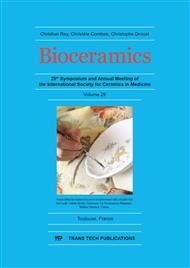p.228
p.234
p.239
p.245
p.250
p.255
p.264
p.269
p.273
Regeneration of Critical-Size Canine Calvarial Defect by Silica-Calcium Phosphate-Composite (SCPC) and Human Adipose Derived Stem Cells
Abstract:
Reconstruction of large maxillofacial bone defects remains challenging even with diverse current treatment modalities. Silica-calcium phosphate nano composite (SCPC) is a resorbable bioactive bone graft material with a strong stimulatory effect on osteogenic gene expression of osteoblasts and mineralized tissue formation. In a prospective experimental study we investigated the ability of SCPC scaffold seeded with human adipose derived stem cells (ADSCs) to regenerate bone in a critical-size canine calvarial defect. Porous SCPC discs were prepared by powder metallurgy method. ADSCs were isolated from human breast adipose tissue, expanded in vitro and differentiated along osteogenic lineage. Bilateral critical-sized defects, 2.5 cm in diameter each, were made in the calvaria of 12 adult dogs. One calvarial defect was filled by either SCPC disc alone (Group I) or SCPC disc seeded with 2.5 x106 osteoblast-like cells (Group II) while other defect was left empty (ungrafted). Bone tissue regeneration and graft material resorption was evaluated 3 and 6 months postoperative using CT and histology. Calvarial defects grafted with SCPC alone or SCPC-Cell construct were grossly repaired while control ungrafted defect did not repair. Microscopically the newly formed bone in the grafted defects was compact and integrated with the surrounding host tissues. Near complete resorption of the graft material was observed. Histomorphometric analysis demonstrated higher bone surface area and more graft material resorption in defects grafted with SCPC-cell hybrid compared to SCPC alone.
Info:
Periodical:
Pages:
264-268
Citation:
Online since:
November 2017
Price:
Сopyright:
© 2017 Trans Tech Publications Ltd. All Rights Reserved
Share:
Citation:


